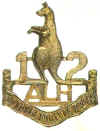 |
| Category:
Lt Horse Regiments |

|
|
|
|
|

12th
Light Horse Regiment (New South Wales)
[4th
Light Horse Brigade]
Served in Egypt, Gallipoli, Sinai, Palestine
Formed New South Wales for 4th Light Horse Brigade.


|
 |
|
Badges displayed
either unofficial or CMF.
|
Battle Honours:
- Anzac,
- Defence of Anzac,
- Suvla,
- Sari
Bair,
- Gallipoli 1915,
- Romani,
- Maghdaba-Rafah,
- Egypt 1915-17,
-
Gaza-Beersheba,
|
- El Mughar,
- Nebi Samwil,
- Jerusalem,
- Jordan (Es Salt),
-
Megiddo,
- Sharon,
- Damascus,
- Palestine 1917-18
|
|
many details on this page from Ross
Mallett's site
|
|
12th Light Horse Regiment
The 12th Light Horse Regiment was
raised, as part of the 4th Light Horse Brigade, at Liverpool, New South
Wales, on 1 March 1915. It sailed from Australia in two contingents in
June 1915. The first contingent put in at Aden on 12 July to reinforce
the British garrison there against a predicted enemy attack; they only
left their ship for a single route march, and sailed again on 18 July
without having seen action.
The regiment was reunited in Egypt on
23 July 1915 and began training as infantry, having been ordered to
leave its horses in Australia. A month later it deployed to Gallipoli.
The regiment was again split up, to reinforce three light horse
regiments already ashore – A Squadron went to the 1st Light Horse
Regiment, B Squadron to the 7th, and C Squadron to the 6th. It was not
reunited until 22 February 1916, by which time all of the AIF troops
from Gallipoli had returned to Egypt.
Returning to its mounted role, the
12th Light Horse joined the forces defending the Suez Canal on 14 May
1916. In ensuing months it conducted patrols and participated in several
forays out into the Sinai Desert. In April 1917 the regiment moved into
Palestine to join the main British and dominion advance. It joined its
first major battle on 19 April when it attacked, dismounted, as part of
the ill-fated second battle of Gaza.
With two frontal attacks on Gaza
having failed, the next attempt to capture the Turkish bastion was a
wide outflanking move via the town of Beersheba, launched on 31 October
1917. A deteriorating tactical situation late on the first day of the
operation caused the 12th and it’s sister regiment, the 4th, to be
unleashed on Beersheba at the gallop – an action which has gone down
in history as the charge of Beersheba.
After Gaza fell on 7 November 1917,
Turkish resistance in southern Palestine collapsed. The 12th Light Horse
participated in the pursuit that followed, and then spent the first
months of 1918 resting and training. It moved into the Jordan Valley in
time to participate in the Es Salt raid between 29 April and 4 May. The
regiment subsequently manned defences on the west bank of the Jordan.
In August, the regiment was issued
with swords and trained in traditional cavalry tactics in preparation
for the next offensive against the Turks. This was launched along the
Palestine coast on 19 September 1918 – it’s objective, Damascus. The
mounted forces penetrated deep into the Turkish rear areas severing
roads, railways and communications links. The 12th Light Horse was one
of the first Australian units to enter Damascus on 2 October 1918.
The regiment was soon involved in the
next stage of the advance and was on its way to Homs when the Turks
surrendered on 30 October. While awaiting to embark for home, the 12th
Light Horse were called back to operational duty to quell the Egyptian
revolt that erupted in March 1919; order was restored in little over a
month. The regiment sailed for home on 20 July 1919. Text from AWM
- 53 killed, 401 wounded
-
Decorations
- 3 DSO, 1 bar
- 5 MC, 1 bar
- 9 DCM, 1 bar
- 14 MM
- 17 MID
|
|